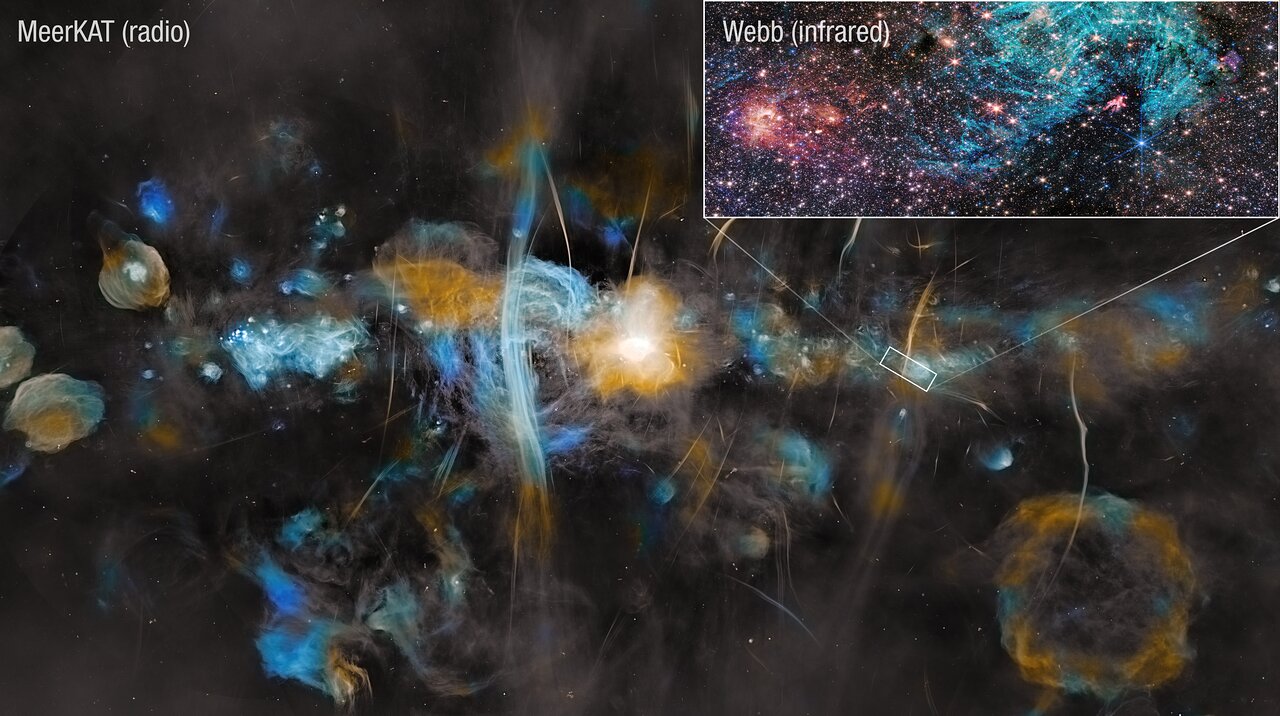Milky Way Center (MeerKAT and Webb)
Follow-up research on a 2023 image of the Sagittarius C stellar nursery in the heart of our Milky Way galaxy, captured by the NASA/ESA/CSA James Webb Space Telescope, has revealed ejections from still-forming protostars and insights into the impact of strong magnetic fields on interstellar gas and the life cycle of stars.
This image of the Milky Way captured by the MeerKAT radio telescope array puts Webb’s image of the Sagittarius C region in context. The MeerKAT image spans 1,000 light-years, while the Webb image covers 44 light-years.
At the center of the MeerKAT image the region surrounding the Milky Way’s supermassive black hole blazes bright. Huge vertical filamentary structures echo those captured on a smaller scale by Webb in Sagittarius C’s blue-green hydrogen cloud. Like a super-long exposure photograph, MeerKAT shows the bubble-like remnants of supernovas that exploded over millennia, capturing the dynamic nature of the Milky Way’s chaotic core.
Astronomers think the strong magnetic fields in the heart of the galaxy are shaping the filaments seen by MeerKAT and Webb, and may also play a role in suppressing star formation in the region. Though there is a rich cloud of raw star-making material in Sagittarius C, star formation rates are not as high as astronomers expect. Instead, magnetic fields may be strong enough to resist the gravity that would typically cause dense clouds of gas and dust to collapse and forge stars.
[Image description: Processed data collected by the MeerKAT radio telescope shows the plane of the Milky Way galaxy, with a graphic pullout highlighting a much smaller region on the right, captured by the James Webb Space Telescope’s near-infrared light observations. The MeerKAT image is colored in blue, cyan, and yellow, with a very bright white-yellow center that indicates the location of the Milky Way’s supermassive black hole. Painterly bubbles of various sizes, clouds, and vertical brushstroke-like streaks make up the radio image. The Webb inset shows stars and gas clouds in red, with an arching cloud of bright cyan that contains many straight, needle-like features that appear more crystalline than cloudy.]
Credit:NASA, ESA, CSA, STScI, SARAO, S. Crowe (UVA), J. Bally (CU), R. Fedriani (IAA-CSIC), I. Heywood (Oxford)
About the Image
| Id: | SagittariusC-region | |
|---|---|---|
| Type: | Collage | |
| Release date: | 2 April 2025, 16:00 | |
| Size: | 7642 x 4272 px | |


